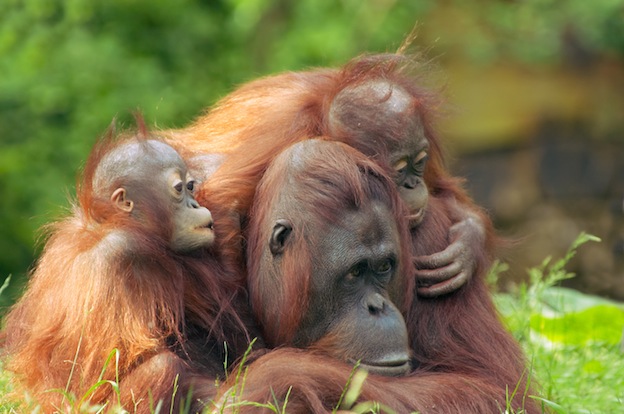Orangutan Social Behavior
Orangutans are loners so they don’t develop the same type of social structure as other apes. They are clearly very intelligent though and able to take very good care of themselves in the wild. Since they tend to live alone, the most we know about them socially comes from their interactions with each other for mating and in regards to the females caring for their offspring.
The males are always the aggressor when it comes to mating. The females are often passive when noticing their advances. This will result in the male making noises to get her interested. They will even force the females to mate if they aren’t able to escape. During all of this, the male may be making tons of noise while the female remains quiet.
The females are extremely responsive to the needs of their offspring. They will protect them from other animals and even male orangutans. They will make sure they get plenty to eat, groom them, and hold them lovingly. It can be very traumatic when a female loses her young to a predator or due to an accident. Then she can make sounds that are similar to crying.
They are very shy animals as well, and they often do all they can to avoid conflict with other animals as well as other orangutans. Even when two males are in conflict with each other one will usually run off rather than the two of them engaging in a physical confrontation.

At night time they will create nests in the trees where they will sleep. They don’t nest in the same place twice which is quite common among apes. For the most part, orangutans are very calm but they can be territorial if necessary. They can be aggressive if they feel that they are threatened or that their offspring is. They have a very large area that they continue to migrate through over and over in order to find food and shelter. This is to help ensure that they don’t deplete any given area of the vegetation there.
There is plenty of evidence to show that orangutans take part in social learning practices with their young. They are one of the few animals that are known to do this. For example, a mother may teach her young how to make a tool to scratch its back with or how to use rocks to open up foods.
The females tend to miss the interaction with their young in the wild. They will often mate as soon as they can after their offspring have left. Evidence shows that the female offspring will likely live in close proximity and they will share time together due to that. The males though will leave and never have contact with their mothers again in the wild.
The social structure in captivity is very different. Usually, there is a group of orangutans instead of just one in a given area. Then they will become even more territorial. The older males will take the areas that they want and the younger males know to stay away from those areas. There can also be aggression among them when it comes to mating with the females.
To help with this, most zoo settings have only one male, a couple of females, and their offspring in a given area. Each orangutan also has a seclusion area where they can go to get the isolation they crave. Even in such a setting though they tend to remain alone and not interacting except with their young. For example, they can be eating at the same location but all with their backs turned inwards so that they don’t even make eye contact.
